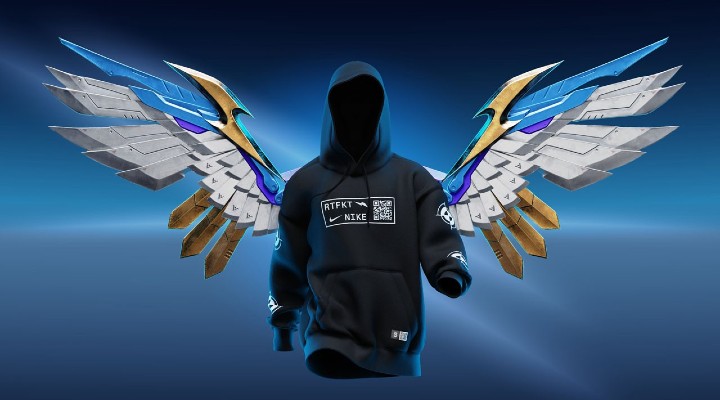It’s no surprise that the largest sports apparel brand in the world, Nike, has bridged the physical and digital divide. The brand recently launched a hoodie designed to be worn with augmented reality (AR) components in real life, and on avatars in virtual environments. Created in partnership with Nike’s Web3 creator studio, RTFKT (pronounced “artefact”), the RTFKT x Nike AR Hoodie begins as a non-fungible token (NFT). It can be worn as a digital garment on RTFKT CloneX avatars an
and forged (meaning manufactured) as a physical hoodie for those who own the NFT.
Those who already own an RTFKT CloneX avatar or the Nike Dunk Genesis Cryptokicks had first dibs at securing the digital hoodie via a private mint, making it an incredibly rare item to buy. The number of physical hoodies to be forged from the AR Hoodie NFTs was also limited – to a short time window – and sold out in a matter of hours, leaving hopefuls not only frustrated but waiting hours in an online queue to find out they missed forging the physical version.
The AR Hoodie followed closely behind the recent Cryptokicks collection of digital sneakers, which can be worn in AR. The physical hoodie takes AR further, with target markers on the sleeves and a QR code on the front activating an AR experience. This allows the user to add effects such as customisable virtual wings attached to the hoodie.
For the lucky ones, their physical item will be shipped in September. A staple in everyone’s wardrobe, the plain black hoodie features simple branding of RTFKT and Nike on the front and back, a QR code, and target markers on the sleeves to activate in AR.
It’s one of the first major apparel projects to incorporate both digital and physical elements. This presents infinite possibilities around the future of fashion and the ways to connect immersive experiences.
The tech connecting worlds
Embedded within the RTFKT x Nike AR Hoodie is a near-field communication (NFC) tag. Owners of the hoodie will be able to scan the NFC tag with their smartphone and access the digital asset directly.
This technology will become commonplace in the near future, as it is a fantastic tool for connecting a physical product with its digital twin. This will provide digital identification and transparency throughout the supply chain and a garment’s lifecycle.
From a marketing perspective, integrating NFC tags into fashion provides a huge opportunity to connect with garment owners beyond the initial purchaser. Encoding a web link or action into the NFC tag within a garment allows anyone wearing it to interact with the brand, introducing new customer experience layers that go further than social media marketing and pay-per-click advertising.
We’re starting to see NFC tags emerge more in apparel. A few years ago, streetwear brand Anti Social Social Club started including NFC tags in all its apparel due to the increase in counterfeit products. Those who purchased genuine ASSC gear, either new or from secondary marketplaces, can download the ASSC app, scan the tag, and within moments verify the authenticity of these hard-to-come-by garments that often fetch a higher price on secondary marketplaces due to their exclusivity and hype.
High value, high risk
The NFT space can be even more expensive than exclusive physical brands, making it difficult for most people to get involved.
The cost to mint the AR hoodie NFT, itself, was 0.221 Ethereum (about $450), but to buy it, you first needed to verify ownership of a CloneX or Cryptokicks NFT by connecting your crypto wallet to the RTFKT website. The floor price for a CloneX x Takashi Murakami NFT at the moment is 8.88 Ethereum ($17,000) and for the Cryptokicks the floor price is currently .86 Ethereum (about $1700).
With so much hype built up around exclusive NFT drops, there are huge risks that the technology may not support high volumes of traffic when minting. Yuga Labs, the creators of Bored Ape Yacht Club, experienced monumental technical difficulties that overwhelmed the Ethereum blockchain when it released its virtual land sales for Otherside, the Bored Ape metaverse.
RTFKT also experienced major issues when it released the AR Hoodie NFT. The private minting event ended quickly but people waited for hours in a queue without knowing it was over. RTFKT posted an apology on Twitter after it became known there was a problem with the minting process and that people weren’t able to save a spot in a queue, getting kicked out without notice.
While these problems are incredibly frustrating, many people remain optimistic about Web3 and digital assets such as NFTs. It’s clear that the industries leading the charge in creating a virtual and interactive future are creative fields such as fashion, music, games, and art. No one ever said innovation comes without risks, but it’s the efforts to improve that pave the way.
It’s crucial to study the moving parts of these large projects. When they’re broken down into components, brands can pick and choose aspects they see are most relevant to their business and audience. These early launches become the blueprint, just as in every other major cultural shift that’s occurred, such as the rise of social media.
Nike has been at the forefront for decades, willing to take risks as a brand and champion what it believes in through the athletes it backs.

